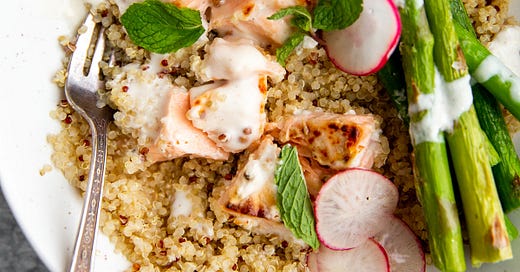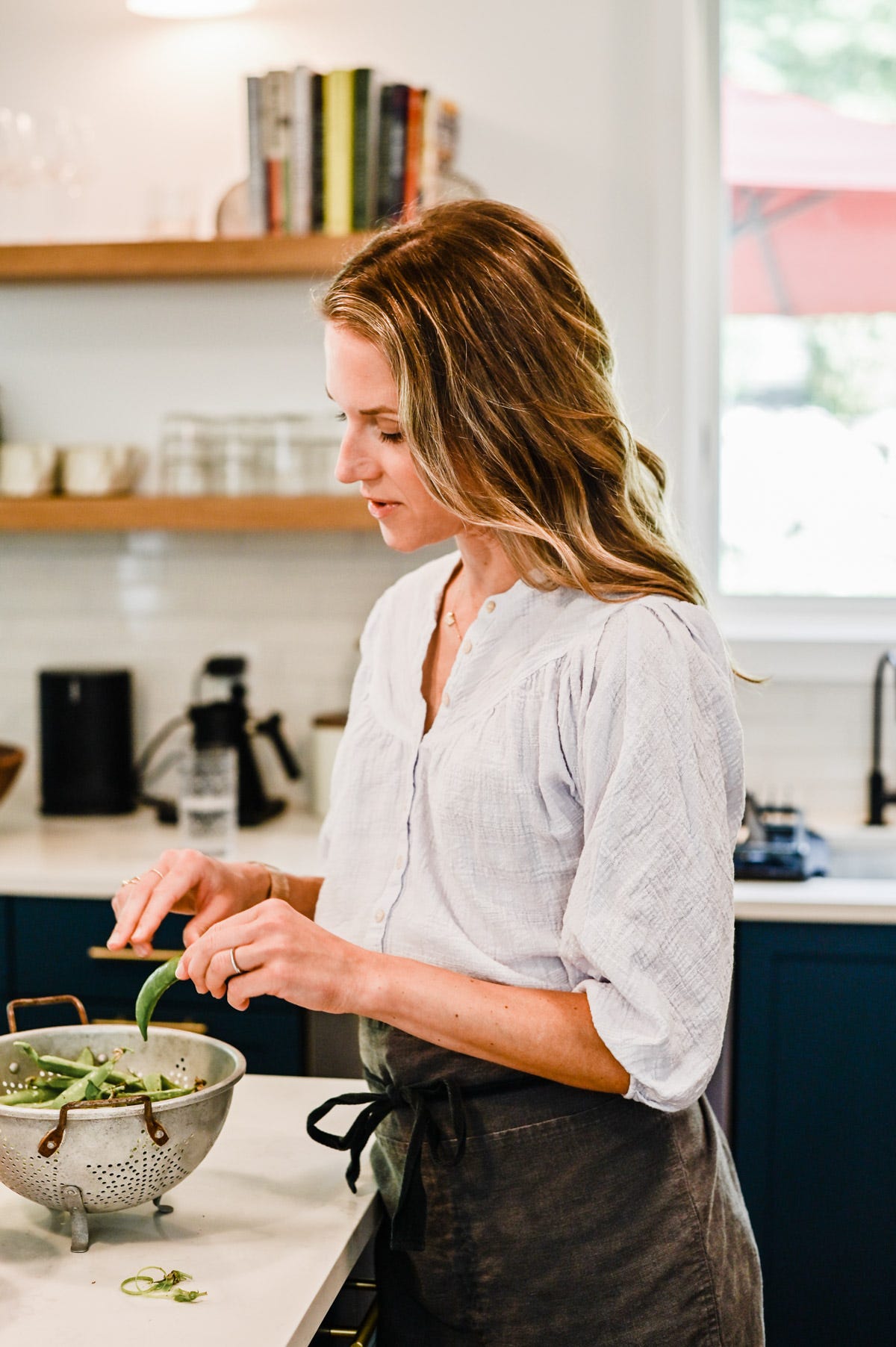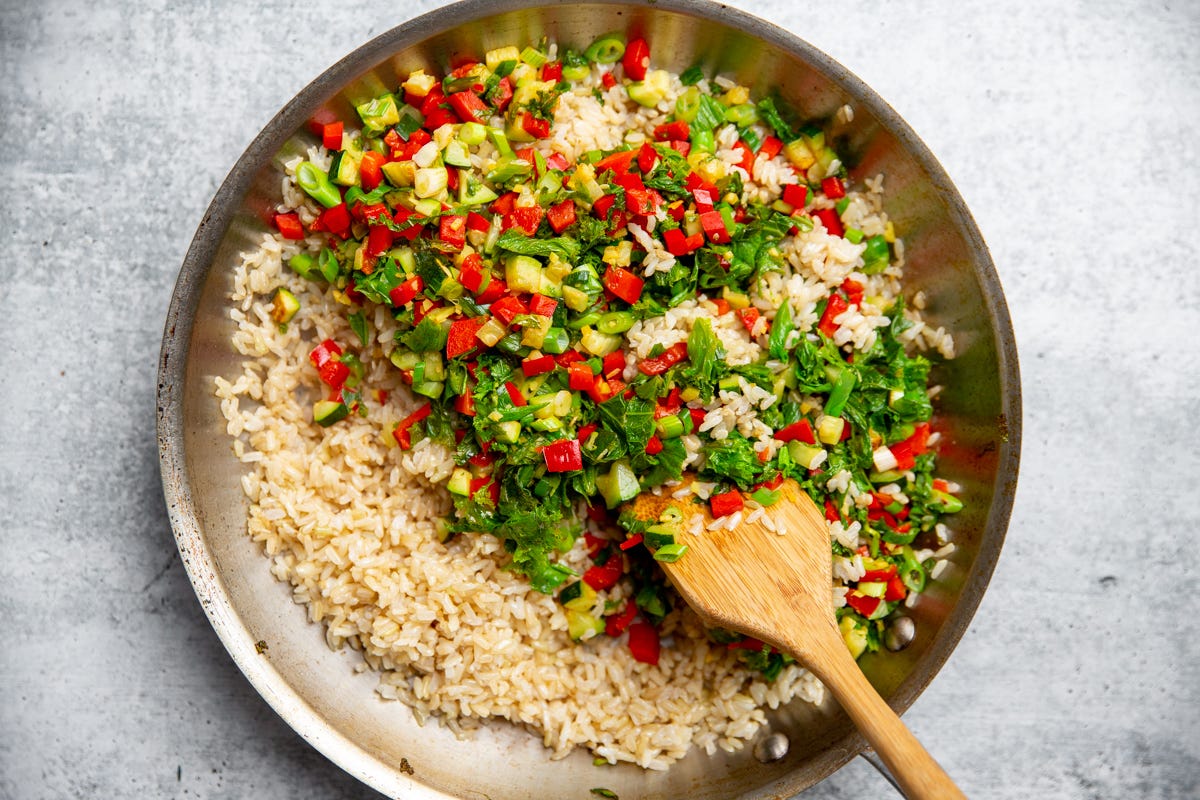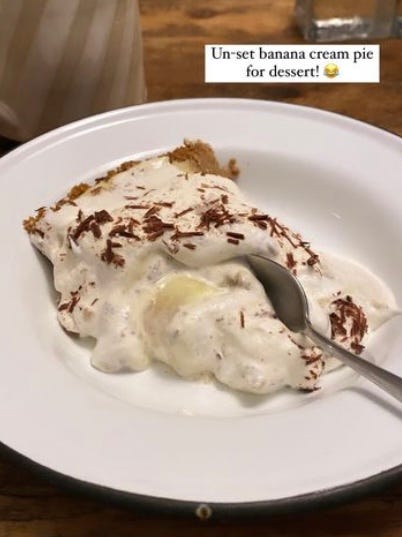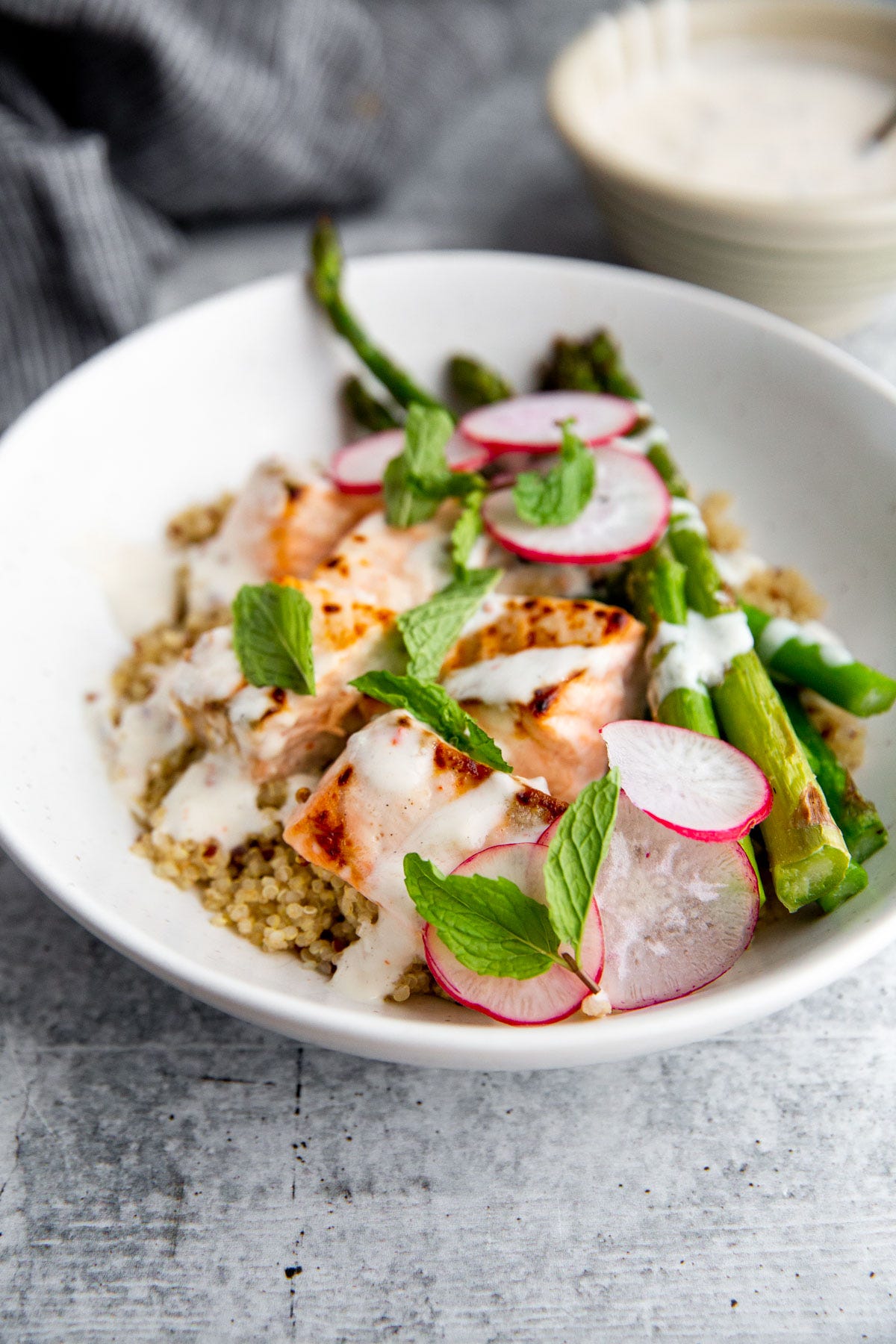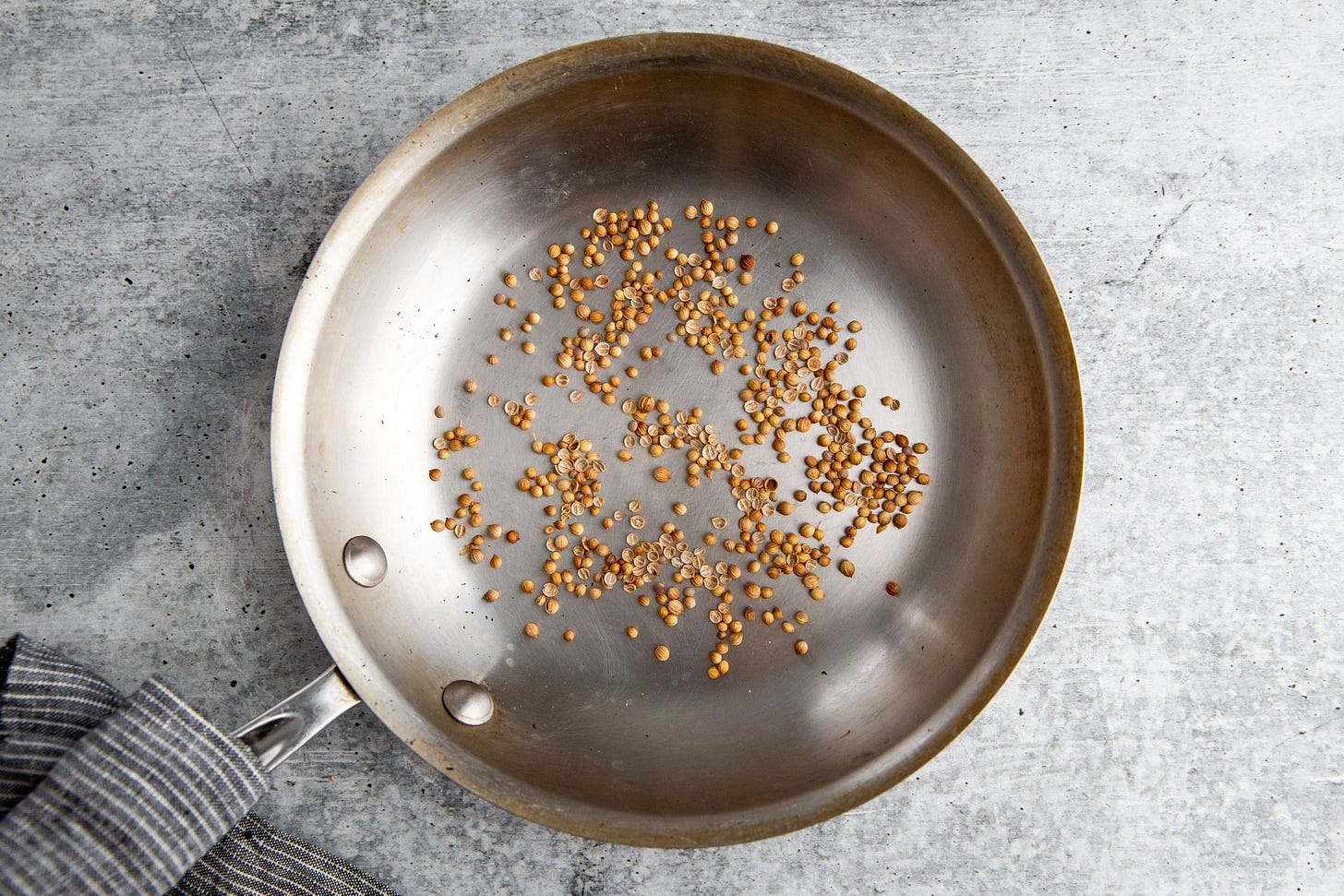Sheet Pan Salmon & Asparagus with Coriander Cardamom Yogurt Sauce + Intuitive Cooking
Spring is officially here, and to celebrate I have a new recipe that celebrates some of my favorite spring flavors (even if in reality we’re still weeks away from warm weather here in the Hudson Valley). We’re making sheet-pan salmon and asparagus with a coriander cardamom yogurt sauce. You can transform the meal into bowls (*yes, I’m obsessed) or you can eat it as-is. It’s light, bright, and pairs perfectly with a glass of rose (*yes, I’m going there).
This is actually not the recipe you were supposed to have this week. I had been planning on featuring a (dairy-free) Banana Cream Pie, but as you might have seen in my Instagram stories, I didn’t add enough cornstarch and when I went to photograph the pie, it wasn’t set. Doh!! Don’t worry, that recipe will be coming soon (it’s worth the wait). Thankfully I had these bowls in the pipeline, which were requested by a paid subscriber—one of the perks of being a paid subscriber is that you get to help dictate the recipes that I develop here.
Before we jump into the recipe, I want to talk about something I’ve been thinking about since my podcast conversation with Calvin Eaton. He explained that his favorite way to cook is to create something intuitively according to what he has on hand and what he’s craving (listen here). This is my favorite way to cook as well—it’s when I can tap into my creativity and simply cook from the hip (or gut?) instead of following (or testing) a recipe.
Intuitive cooking
I call this intuitive cooking. I don’t know if there is an “official” definition, but I define it as: using your intuition and instincts when cooking rather than following step-by-step measured instructions. While this requires a basic understanding of ingredients and techniques, more importantly, it necessitates a level of self trust, a connection to your senses, a level of creativity (and willingness to fail), and practice.
Self trust
Instead of relying upon instructions to tell you what to do, intuitive cooking has you rely on your own instincts. This requires a level of self trust. In her recent newsletter,
explains that an easy way to build trust in ourselves in the kitchen through is through salting to taste. We all have different thresholds for salt (which is why I never include salt quantities in my savory recipes, only for baked goods), and I think this is a brilliant place to start. She states:“…the truth is we all have the ability to taste and adjust for our own benefit. The hard part is trusting the information that is there… We are taught throughout our lives to look to the experts for guidance in so many things that we forget we are the experts on our own bodies and what they need. So when we taste for salt, [and] listen and act on the answer given, we build intuition and self trust. And as we build this self trust in small ways, over time, we can rewire our brain so that we have the foundation we need to be secure in ourselves.”
Another way to build trust in your palate is to taste your dishes for acid. Often when a dish feels flat (or if it tastes like it’s missing something), a spritz of lemon juice, lime juice, vinegar or hot sauce will wake it up. Start paying attention to the salt and the acid in the foods you cook, even if you’re following a written recipe—this will help you learn to trust your own palate.
Connect to your senses
Cooking intuitively requires us to be present with not just taste, but with our other senses as well. Sight is pretty obvious, and I talk about touch in this newsletter, but hearing and smelling are also crucial.
When we’re tuned in, we can hear how the sizzle in the skillet changes when the vegetables are tender (the sound will slow down as water evaporates). Conversely, if the heat is too high, the sound will be frenetic. You can hear if the oil is hot enough when pan-frying—the food should instantly start to gurgle and hiss. You can even hear when a cake is ready to come out of the oven by placing your ear near the surface. As it bakes, steam escapes and the cake will crackle, but this sound calms down when it’s ready.
Similarly, our sense of smell can be a cue that the rice is almost ready (it will smell nutty), that the nuts are toasted (or burnt, which is a bit too common in my house!), that the garlic is golden, that the steak is caramelized, etc.
As we consciously use our senses when cooking, we start to gain confidence in our own body’s cues. This allows us to rely less upon what a recipe tells us (e.g. “sauté for 2 minutes”) and more upon our instincts.
Get creative (and don’t be afraid to fail)
When we begin to trust ourselves and connect to our senses, we can get more creative in the kitchen. While it’s great to follow recipes (recipes are great! I write them for a living!), I love cooking without a recipe. That’s when I get to be fully present for the process instead of being tied to a set of instructions—adjusting, tasting and playing.
While cooking without a recipe does require a basic understanding of how foods taste together, this can be started in the smallest of ways. Maybe it’s with a sandwich variation you’ve been dreaming about (I can’t stop thinking about fried eggplant, roasted tomatoes and burrata…). Or you can get creative with a one-bowl salad, or whip up a no-recipe marinade for chicken. Fried rice is also a wonderful dish to tap into intuitive cooking—start with a mix of finely chopped vegetables and meats, add day-old rice, and finish with tamari, sesame oil and sriracha to taste.
Experimenting with flavors and techniques requires a willingness to fail. Not all experiments will turn out (which is why I always keep boxed pasta in the house!). That banana cream pie that turned to a puddle in the crust? Failure. But you know what? I learned something invaluable about the ratio of liquid to starch. My daughter Ella often bakes cakes without using recipes—she just adds flour, sugar, eggs, milk and flavorings until it “looks good” then pops it in the oven. Yes, there are many failures, but I’m shocked at how many of her creations do taste good. Most importantly, she has fun, and she keeps learning. It’s all about building the trust muscle.
Tap into your cravings
As you start to become a more intuitive cook, you can also become a more intuitive eater. Even if you’re following a recipe, you can begin to adjust ingredients according to what your body is craving (or not). Maybe you’ll stir a few handfuls of spinach into the soup if you’re wanting some greens, or slip some chicken or shrimp into the veggie curry if it’s protein you’re after. Maybe you’ll omit the heavy cream from the stew if your body is saying no-dairy-right-now-please-and-thank-you. When I’m having a Lyme flare-up and am experiencing a lot of inflammation, my body will naturally crave fewer grains and more fish, nuts and fats (during those times I find very interesting ways to add avocado, nut butter and aioli to everything 😂).
Intuitive cooking is all about responding to the ingredients in front of us instead of being tied to written instructions. It’s about being present, trusting in our instincts, listening to our bodies, and allowing ourselves to get creative in the kitchen. And like anything else in life, it simply takes practice.
Make it a practice
As intuitive leadership and life coach (and dear friend) Nicole Beaudin stated in her (very synchronous) coaching newsletter this week, “A small change, done consistently, creates big impact over time.” She suggests asking your intuition to help you prepare dinner every night for one month. This consistent practice will help strengthen your relationship with your intuition as well as create a deeper trust with yourself.
Tips for becoming a more intuitive cook:
Learn to trust yourself
You can start by learning to trust your palate. A simple way to do this is by salting to taste and tasting for acid in the dishes you prepare.
Connect to your senses
When you consciously connect to all of your senses when cooking you can respond to the food in front of you instead of relying on written instructions. In doing so, you can begin to trust your instincts.
Get creative (and don’t be afraid to fail)
Try cooking without a recipe (it’s okay to start small!). Experiment with different flavors and techniques, and when things don’t turn out, learn from the experience (it’s okay, seriously).
Tap into your cravings
Tune into your body, asking it what it’s wanting. Cook meals and adjust recipes to satisfy your cravings. As you do so, you’ll become a more intuitive eater.
Talk to your intuition
Ask your intuition to help you prepare dinner every night for one month. By making this a consistent practice, you’ll strengthen your relationship with your intuition.
Sheet Pan Salmon & Asparagus
Today’s recipe is a dead-simple sheet pan meal that can also be transformed into beautiful bowls. Part of the reason I love bowls so much is that they allow for creativity—you get to tap into your own tastes and cravings when building your bowl (I’ll take ALL the sauce, please). Chunks of marinated salmon are broiled alongside asparagus, but the real star of the meal is the coriander cardamom yogurt marinade, which does double duty as a sauce. It’s flavored with ginger, cardamom and honey, with pops of flavor from whole coriander seeds.
If you haven’t used coriander seeds before, they’re absolutely lovely (they come from the cilantro plant). When toasted they have a surprisingly fruity flavor that reminds me of Fruit Loops. While most recipes call for crushing the seeds, here they’re left whole, lending the dish a delicious pop of flavor with every bite.
Keep reading with a 7-day free trial
Subscribe to Mind, Body, Spirit, FOOD to keep reading this post and get 7 days of free access to the full post archives.


